Fukagawa Hachiman Matsuri Festival 深川八幡祭り
|
|
|

Every three years (2017, 2020, 2023, 2026, etc.), the full-scale version of this festival is held in mid-Aug. The festival's last day is the climax with this procession of over 50 portable shrines. Led by this banner which reads Tomioka Hachimangu.
|
|

Shrine priest on horseback. The start of one of Tokyo's Big Three Festivals. These photos show the festival's climax on the last day of the festival when over 50 portable shrines are paraded along the streets amid splashing water. It is the Rengo
|
|

Omiko shrine maidens. On the previous day during the Sacred Carriage Procession, they performed sacred dances on a truck. お巫女
|
|

Tekomai geisha. Their costume is colorful and partially masculine with trousers instead of skirts. Their right shoulder is "exposed" to show a peony flower (botan) design. They carry a red paper lantern imprinted with their names.
|
|

Tekomai geisha. They existed since the Edo Period. They served as side entertainment at festivals. They only sing traditional chant-like songs called kiyari. 手古舞
|
|

This troupe of 25 local women preserve a traditional art of Edo. They attend regular singing practice led by an elderly woman who was an authentic tekomai in her day.
|
|

This is early in the morning when the 54 portable shrines who had gathered in front of the shrine depart for the procession one after another.
|
|

In front of Tomioka Hachimangu Shrine on Eitai-dori road.
|
|
|
|
|

As the mikoshi depart, there is some entertainment at the Tomioka Hachimangu Shrine.
|
|

Taiko drummers at Tomioka Hachimangu Shrine.
|
|

In front of the shrine, a shrine priest blesses each portable shrine as it departs to join the procession.
|
|

The portable shrines are paraded through a route which will take them almost all day to complete, from 7:30 am to 3 pm.
|
|

The mikoshi are splashed with water in whichever way possible. This is in the middle of summer, so it's a good way to cool off.
|
|

Each mikoshi is preceded by a row of women carrying lanterns and wands. Also see the video at YouTube
|
|

People in happi coats carry the mikoshi while shouting "Wasshoi, wasshoi!"
|
|
|

Standard uniform of portable shrine bearers (for both men and women).The headband may be tied at the front or back of the head. It may also be tied on the head like a bonnet. There is a variety of ways of tying the headband.
The happi coat bears the name of the parish or district the person belongs to. The same name is displayed on the respective portable shrine. The shorts are white and skintight. Worn by both men and women. Also called Han-momo or Han-momohiki. The white tabi (sock-like shoe) has a rubber sole.
|
|
|
|
|

"Hey Ho, Let's Go!"
|
|
|
|

This mikoshi is being carried by all women, already soaked to the bone. They carry the mikoshi flat on their shoulders. This is called "Hira katsugi," literally "flat carrying."There are four basic methods of carrying a portable shrine. This is the most basic method where they carry it flat on their shoulders. This is called "Hira katsugi," literally "flat carrying."
|
|
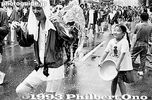
Splash you. This is a day when kids can be mean to grown-ups. This little girl kept filling up her bowl and ran around splashing some unlucky person.I hope that's her school teacher.
|
|

Water splashing truck near Kiyosu-bashi Bridge
|
|

Water hose at Kiyosu-bashi Bridge
|
|

Crossing Kiyosu-bashi Bridge over Sumida River.
|
|

Crossing Kiyosu-bashi Bridge
|
|

Crossing Kiyosu-bashi Bridge
|
|

Raising the mikoshi on Kiyosu-bashi Bridge
|
|

Crossing Kiyosu-bashi Bridge. They chant "wasshoi wasshoi!" as they carry the mikoshi. 清洲橋
|
|

Crossing Kiyosu-bashi Bridge
|
|
|

With raised arms, this is one way to carry the mikoshi.
|
|

A horde of people follow each portable shrine.
|
|
|
|
|

Phoenix atop a portable shrine.
|
|

Kiyosu-bashi Bridge over the Sumida River, Important Cultural Property 清洲橋 国の重要文化財
|
|

Crossing over Eitai-bashi Bridge. 永代橋
|
|

Tekomai geisha cross Eitai-bashi Bridge to enter Koto Ward along Eitai-dori.
|
|

手古舞
|
|
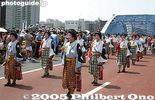
Tekomai geisha at Eitai-bashi
|
|

Tekomai geisha at Eitaibashi
|
|

Tekomai geisha
|
|

They sing and chant while walking slowly.
|
|
|
|

They have flower hats, but I've never seen them wear it on their heads.
|
|

Tekomai geisha on Eitai-dori road, entering Koto Ward
|
|
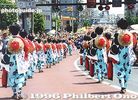
They do not get water splashed.
|
|
|
|

A portable shrine crosses Eitai-bashi Bridge.
|
|

A portable shrine crosses Eitai-bashi Bridge.
|
|

Another portable shrine crosses Eitai-bashi Bridge.
|
|

Using a water hose is an efficient way to get people wet. But see what the big boys use..
|
|

A fire hose. The local fire department with a fire hose on Eitai-dori avenue.
|
|

The water hose is now handled by volunteers, not real firemen.
|
|

Every time, the water hoses are at the same location.
|
|

Water spray
|
|
|
|

Wet face
|
|
|

Crowd on Eitai-dori road
|
|

After crossing Eitai-bashi Bridge, the portable shrines headed for the main stretch on Eitai-dori avenue already filled with people. The wettest and most crowded part of the festival is held along this one kilometer of road between the bridge and shrine.
|
|
|

This is the final stretch and wettest part of the festival.
|
|

Prepared for the water...
|
|

A large truck filled with water with people using buckets to splash water in rapid succession.
|
|

View from behind the "water truck." This goes on for about 15 seconds. The truck is refilled with a fire hose. All in the name of purification.
|
|

During a break, two kids get water.
|
|
|
|
|

Fukagawa Hachiman Matsuri, mizu-kake
|
|

The mikoshi is raised high as they all bathe in water. Taking photos like this one requires adequate water protection of your camera and lens.
|
|
|

Onegaishimasu! お願いします!
|
|

Hai, OK (ha-ha!).
|
|
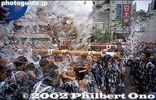
For some reason, it's fun to see people get wet...
|
|

Getting wet upside down might be an extra thrill...
|
|

In front of the water truck. Soon to be filled with people and a portable shrine.
|
|
|
|

My video of a water truck splashing water on mikoshi.
|
|
|
|

Wet women
|
|

Large crowd watch the mikoshi parade near Tomioka Hachimangu Shrine on Eitai-dori road.
|
|
|
|
|
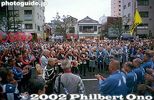
Hand clapping
|
|
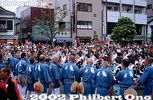
The tekomai geisha arrives at Tomioka Hachimangu Shrine.
|
|

The tekomai geisha enter the shrine.
|
|
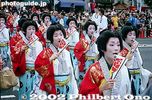
The tekomai geisha enter the shrine.
|
|
|

The tekomai geisha enter Tomioka Hachimangu Shrine.
|
|

As the portable shrines reach the shrine, they give one last show before returning to their parish.
|
|

Tossing a mikoshi.
|
|

The portable shrine gets a final mid-air toss while passing by Tomioka Hachimangu Shrine. This mid-air toss of the portable shrine is called "mai-age" or tossing up.
|
|

Crowd at the shrine entrance.
|
|

One after another, the mikoshi arrives in front of the shrine.
|
|

And give their last show.
|
|
|
|

Being at the shrine's torii entrance is a great place to watch the mikoshi.
|
|
|
|
|
|
|
|
|
|
|
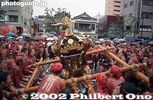
Dramatic display of mikoshi maneuvers
|
|
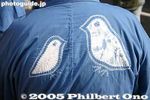
The shrine's happi coat has a design for the character "Hachi" (for Hachimangu) consisting of two pigeons. Pigeons are regarded as the messengers of the deity worshipped at Hachimangu shrines in Japan.
|
|
|
|
|
|
|